Well folks, R/C Rock Crawling looks like it's as popular as its full size counterpart. Many enthusiasts are off building custom rigs specially designed to maneuver the complex courses and challenges of a typical Rock Wall.
We're here to help you do just that. With a few steps, and some materials, we're going to show you how to convert your Wheely King into a Crawler King.
Pre-Build Considerations |
Make sure you start with a clean work area ( Or Crawl Space =] ). Having a clean work area helps you keep track of the little parts(There are lots of them!) For our project, we're using a Pit Mat from Upgrade RC called the Pro Mat.
We start off with a Wheely King 4x4 RTR right out of the box. In Phase 1, we'll be making some changes to the drivetrain and suspension. Be prepared to set aside a block of about 3 hours for this project. |
| |
Before we get started, you'll need to pick up a few parts. Most of these parts can easily be found at your local hardware supply store or hobby shop.
Our goal was to keep this project as low budget as possible and still come up with a decent rig.
Here's the readable version:
| 82008 Driveline (x1) |
$21.99 |
| 82009 Driveline (x1) |
$11.99 |
| 6996 96t Spur (x1) |
$4.00 |
| 6915 15t Pinion (x1) |
$4.00 |
| 86059 Balls (x2) |
$6.00 |
| 85230 Rod Ends (x2) |
$8.00 |
| Liquid Steel (x1) |
$5.95 |
| 640 All thread (Home Depot) (x1) |
$2.69 |
| 12” 4-40 All thread (x1) |
$1.30 |
| 3031 1/4 x .049 Round Tube (K&S) (x2) |
$2.49 |
| 4-40 Lock Nuts (x2) |
$.79 |
| Total |
$65.20 |
We did most of our shopping at Ultimate Hobbies which is pretty local to us. The prices you see are about what you'd expect to pay at your local hobby shop. Some items may be more or less, so call ahead if you're unsure. The other items we picked up at various hardware shops. |
| |
The Work Begins |
To get a proper start, the first step for us is to find a good place to put the Wheely King logo. We chose the Pit Mat so we could easily remember what the truck started out as when we go into Phases 2 and 3.
This is one of the most important steps. Like those people who put the stickers of their latest computer hardware up and down the side of their case: Same thing. Some would argue you can't even start the project until you know where your logos are going. =)
|
| |
We set off to pick up our shopping list.
|
| |
|
|
| |
Ultimate Hobbies is one of the biggest Hobby Shops in So. Cal.
|
| |
|
|
| |
Checking my list twice to make sure I have everything.
|
| |
Moto, our friendly counter parts guy (and an avid racer too)
|
| |
|
K&S has the links we need #3031 1/4 X.049 tube. |
We bought the parts we'd need for both Stage 1 and Stage 2 |
On our way back. |
|
| |
Digging In |
| |
To start, remove the body from the chassis and give it a once over. Make sure you familiarize yourself with the contents of the box; Truck, manual, controller etc...
|
| |
Remove the wheels and tires. Don't get rid of them yet, Stage 1 uses stock wheels and tires so we'll be putting them back on later.
|
| |
It's not enough to stress the importance of a neat work area while you're doing this. When you remove a part, keep it with other similar parts. When you remove the shocks, keep all four next to each other.
Just be sure to keep everything organized while you're working.
|
| |
Remove all four shocks from the Wheely King so it looks like this.
If you're wearing Sunglasses, now would be a good time to take those off as well. As you can see, we've placed ours in an out of the way area next to the tires.
|
| |
Time to remove the rear sway bar. This will take about a minute as there's only four screws to take out. This will eliminate the roll reduction, but this will give us that much needed articulation for a crawler.
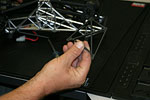
We will not be using the rear brace for anything. Feel free to do what you want with it. |
| |
The suspension is already looking pretty good. The articulation achievable from a stock Wheely King is a nice hidden feature. The next thing we'll do is remove the front and rear axles in preparation for locking the diffs.
|
| |
Alright, so it's time to remove the front and rear suspension. We'll be replacing these with custom ones built from the all thread, aluminum tubing and extra Rod Ends we picked up for the project.
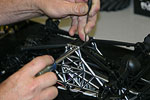
Placing a small screwdriver in the center hole of the link helps keep it from turning.
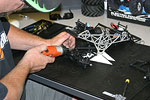
Using an electric screwdriver helps things move much faster. |
| |
Disassemble the steering and remove the front and rear axles. Your truck should now be in three major pieces: The main chassis, front and rear axles with the shocks waiting patiently to the side.

|
| |
Axle Disassembly |
Next step is to disassemble both axles. The axles are the same on the front and back, so the instructions are the same for both.

When you're removing the linkage, keep an eye on the e-clips. They're hard to find when they go zooming across the room...
You should be wearing eye protection already, but make sure you wear them during this step. If you think getting an e-clip off a pin is difficult, imagine trying to pull one out of your eye...

Slide out the pins from the linkage and set them aside (Keep them together though! They're tiny!)
|
| |
The next step is removing the C Hub. Remove all four by unscrewing the front and rear screw from the housing.
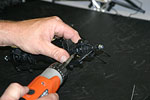
There are two screws per side, so don't forget to take the other ones out. (The old "Flip it over" technique)
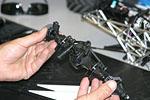
The hubs will slide apart at this point.
|
| |
Locking the Diff |
Now we need to disassemble the differential so we can lock it. Start by removing the four screws holding the diff case together. Do this to both sides and your axles should look something like this now:
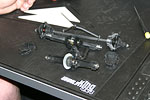
|
| |
Now that we have the differential out, it too needs to be taken apart. We're going to clean the grease out and replace it with a two part epoxy, or other hardening material. The idea is to restrict all diff movement so the wheels won't spin if you're in a tight spot and have a wheel stuck.
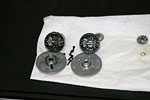
We've cleaned all the grease out of the one on the right. That's how it should look before moving on. Put the gears back in except for the gear that sits against the drive gear. Set it aside for now.
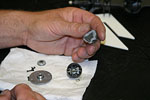
We're using a two part epoxy putty for ours. Liquid Steel or other such compounds are perfect for this application.
|
| |
If you're using a two part putty of some sort, be sure to mend or knead the compounds well enough that the chemical reaction starts.
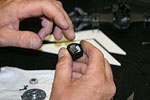
Pack it in to the gears well. You want to keep them from moving at all.
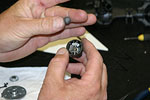
The easiest way I've found is by making small balls and pushing them in on both sides.

Add one more on the top.
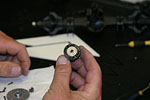
Now press the gear you took out onto the top of all of it.
|
| |
Reassemble the diff. Let it set up for a couple minutes then check it. You should NOT be able to alternately rotate the drive shafts.
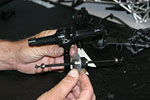
Put the diffs and axles back together.
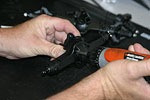
Again, electric tools make life easier.
|
| |
Build the shafts by cutting the aluminum tubing and all thread to the lengths shown in the photos.
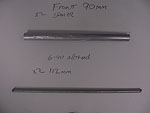
Make two of these for the front
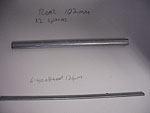
And two of these for the rear.
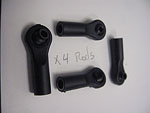
You'll be inserting the all thread into the ball ends.
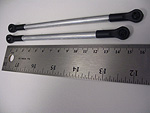
Once you've made all your cuts, screw one end of the all thread into a rod end until it's snug. Slide the cut aluminum tube over the all thread and screw the other rod end on until the whole assembly is nice and tight.
|
| |
Next, cut the link between the suspension arms and keep the link.
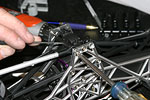
Screw in the new rod ends to the chassis with the link between them. You may have to use small washers as spacers for this step.
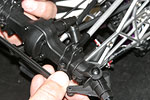
Then slide the pins and e-clips back in place.
|
| |
Next, we'll be lengthening the top link with another all thread/aluminum tube assembly. For this application, use the 4-40 all thread. Cut the front to 28mm and the rear to 37mm.
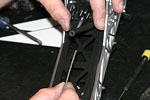
Use the 4-40 all thread for this.
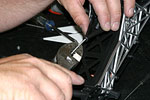
Use pliers or double nutting for this. Do not over tighten this.
 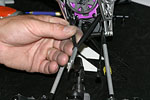
Install the spacer

Varying the length of the spacers allows you to make camber adjustments.
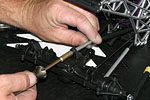
Use a 4-40 lock nut to secure the top link in place.
|
| |
Suspension Reassembly |
Ok, time to put the shocks back on. Install the pins and e-clips into the bottom of the shock.
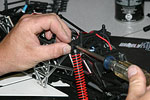
Then mount the upper and lower parts of the shock in the stock location.
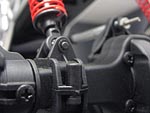
We're done with this part.
|
| |
Drivetrain |
In order to get that low end torque from the stock motor, we're going to be swapping out the pinion and spur gears. The pinion will be moving from a 21t gear to a 15t gear. The spur gear is going to be taken up to a 96t gear, up from the 90t stock gear.
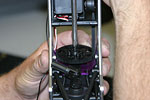
Remove the center bolt. Be careful not to lose the pin.
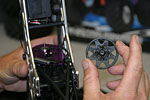
Remove the four screws from the Spur gear.
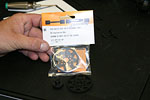
Replace the Spur gear with #6996 Spur gear and the stock pinion with the #6915 15 tooth pinion.
 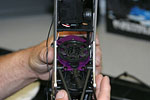
Then reinstall everything and reset the gear mesh. This part's done.
|
| |
Due to the longer suspension, we now need to swap out the stock drive shafts with the stock E-Savage drive shafts. Part #82009 for the front and #82008 for the rear. The rear drive axle will have to be cut down 13mm to fit on the rear of the truck. It is a little to long , mae sure to keep it a clean cut to let it slide.
|
| |
Finishing Up |
These last steps are just a few finishing touches that will help you keep the rig in good working order.
I tend to wrap the servo wire around a small screw driver. This will keep it wound tight and out of the way.
 Also, wrap the ant. wire around the chassis and use a small ant. tube to keep it under the body.
Also, wrap the ant. wire around the chassis and use a small ant. tube to keep it under the body.
 12.5 inches is legal length for the 2.2 class
12.5 inches is legal length for the 2.2 class.
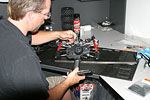
Last step is to install the radio antenna and batteries.
|
| |
There are a few modifications that need to be done to the body so it will have the clearance of a competition class crawler. This can easily be done with a pair of curved scissors.
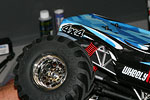
When you've trimmed the body, move the tires up and down to make sure they've got enough room to move.
 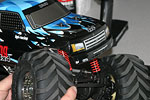
The front is the same. Trim and check for clearance.
|
| |
The last few steps are clean up and light modification to help the crawler get up and over tough spaces with a body on.
Clean up the trimming as best you can. Keeping the body free of hanging lexan will make for a smoother
ride over the rocks.
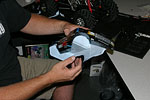 Folding the bottom of the body will give you more clearance for those tight sections
Folding the bottom of the body will give you more clearance for those tight sections.
 Install the front tires backward for more traction
Install the front tires backward for more traction.
|
| |
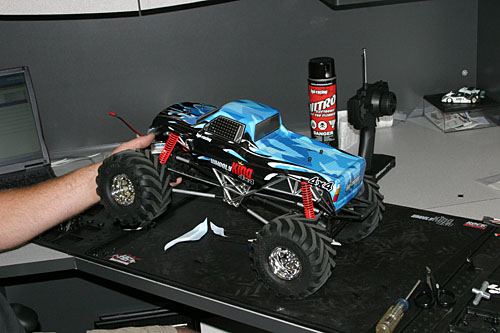
That's it, you're ready to crawl! |
| |
Test Run |
|
|
| |
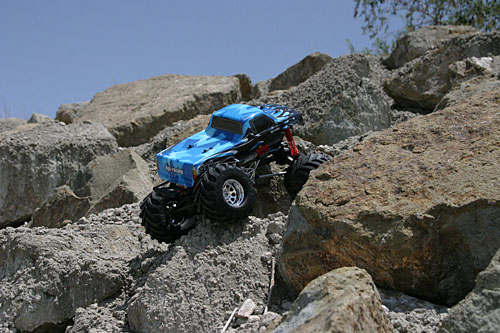 Watching the truck work over rock is AWESOME!
Watching the truck work over rock is AWESOME! |
| |
 I use a steep incline to help me adjust the suspension
I use a steep incline to help me adjust the suspension. |
| |
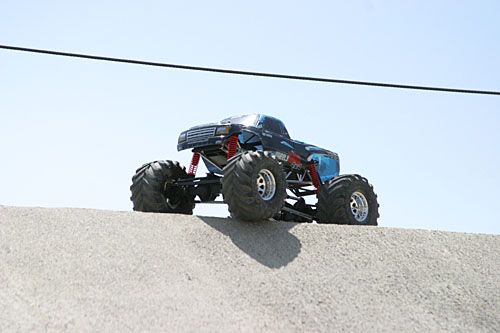 Very good day!
Very good day! |
Well that's basically it! For about $65.00 you can convert your Wheely King into our stage 1 Rock Crawler.
|
To view this article as it was originally posted on the HPI Racing website CLICK HERE |
|
|
|
|